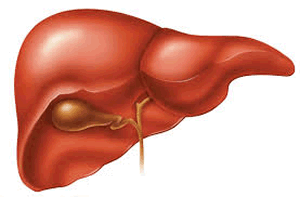Liver
The digestive system breaks down food and absorbs it into the blood stream. The first port of call for the blood after leaving the digestive tract is the liver. The liver prepares and dispatches nutrient molecules to various parts of the body where they are needed.
Glucose is a very important fuel for the body especially the brain which used only glucose as its fuel source. Only during periods of starvation will the brain use other fuel sources. The liver, in association with insulin from the pancreas, controls the levels of glucose found in the blood. As blood rich in glucose arrives at the liver from the digestive tract, the liver acts in three major ways to maintain a constant blood sugar concentration.

Firstly, it may use some of the glucose in the blood to provide energy for its own cells.
Second, it may store some of the glucose as glycogen. Glycogen is a long polymer made of glucose molecules joined together stored in liver cells. When blood sugar levels are low, glycogen is broken down to glucose molecules which are then released into the blood stream
Third, glucose may be converted to fat and dispatched to special cells for storage. This only happens after a meal where the blood sugar levels are high and enough glycogen is already stored.
Some other functions of the liver include the:
- production of bile which
is stored in the gall bladder and secreted into the small intestine to
assist in the break down (digestion) of fat.
- storage of vitamins and minerals such as iron.
- the removal and eventual breakdown of old, red blood cells.
- chemical breakdown of hormones and toxic chemicals in the blood, such
as alcohol or drugs. The products of this breakdown are then filtered
from the blood by the kidneys.
Complete the sentences below.
1) Glucose concentrations in the blood
2) Glucose reaching the liver may be
3) Proteins can be broken down to amino acids which are then further chemically changed into
4) During long periods of starvation the blood glucose concentration remains constant because the liver breaks down
5) Why is it that after drinking alcohol you must wait for some time before it is cleared from your blood?
The liver synthesizes and secretes at least four important hormones:
- Growth Factor-1 (IGF-1) - stimulate bone growth
- Angiotensinogen - is a precursor to angiotensin, a hormone that plays a role in controlling blood pressure by constricting the walls of arterioles.
- Thrombopoietin - stimulate the development of platelets which are involved in blood clotting.
- Hepcidin - inhibits the release of iron from intracellular stores into the blood. Since microbes require iron to maintain cellular function starving microbes of iron has an antimicrobial outcome.
- Betatrophin - stimulates the proliferation of insulin secreting cell of the pancreas.
6) During infection what hormone is most likely to be secreted by the liver?
7) What would be expected to occur if betatrophin was secreted into the blood stream over a period of time?
8) Dilation of arteriole walls reduces blood pressure. Explain how angiotensin controls blood pressure.
9) During puberty growth is accelerated. Which hormone is most likely secreted during this period of development?
10) What symptoms would a person show if their liver failed to produce thrombopoietin?